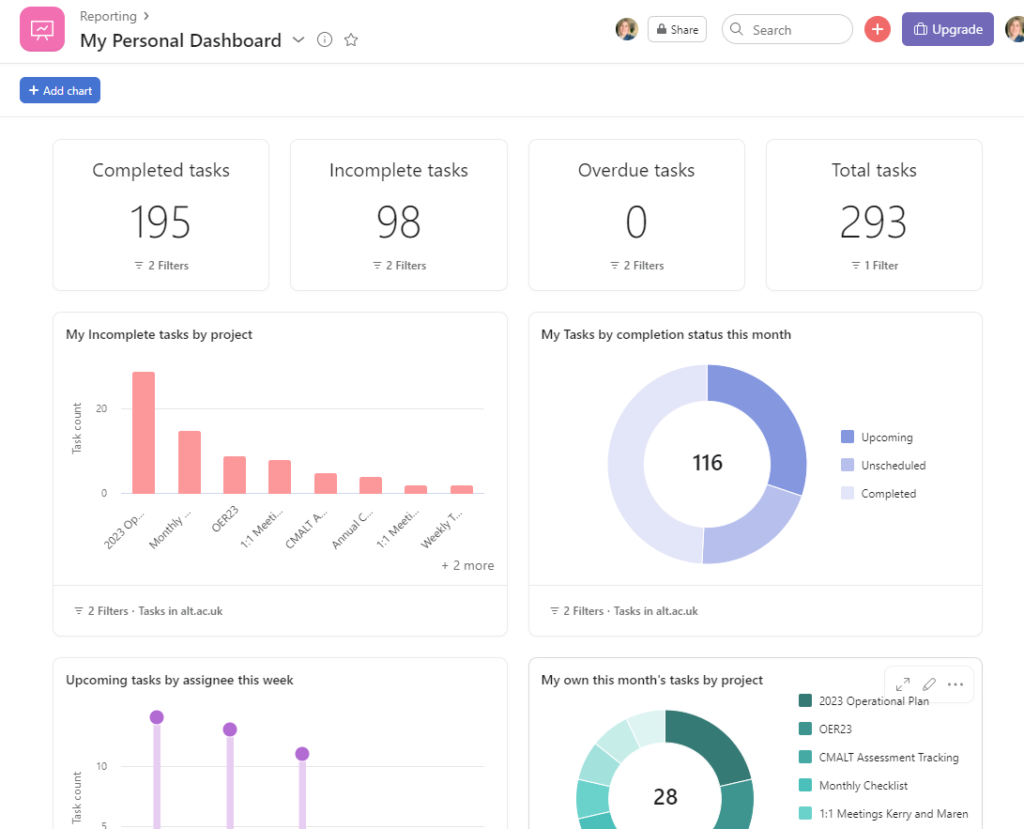In my last post, I reflected on the benefits of a monthly newsletter as a tool for reflection and monitoring progress. For example, I shared how looking at my blog posts for the month gives me a chance to think about aspects of my work I have enjoyed and want to do more of, things I’d prefer to spend less time on, what I want to focus on in the coming month and what is going on the back burner or stopping all together.
This kind of approach, focusing on what to stop/start or do more/less of is generally helpful, but I find it particularly effective when I review what I have been working on and can use specific examples. Now, in my CEO role, my team and I have started to use Asana last year to support collaboration and reporting across the organisation. I found it extremely useful from the start, but transferring all of my personal to do lists and productivity habits into a new platform has taken some time. As I became more confident in the platform, I found new ways to manage my workload and to review my own progress.
One example of this, is that I have started to use Asana more for my weekly work planning, and I wanted to share some tips about how I do that:
1. Reporting
The reporting menu in Asana comes with a “My first dashboard” set up, and I have used this to set up a personal view of tasks by going into each one of the charts and adding a filter that selects only me as an assignee of the tasks being reported on. This way, I can see all of my tasks at a glance.
It’s the first time in my career that I can analyse my workload at this level of detail, and it’s fascinating to compare my own sense of how things are going and what I am spending time on with what the dashboard view captures. It’s a useful exercise for me to consider what’s not being captured and why.
Most of the time, I find leadership related activities are absent from the reporting. Although I have both shared and private plans that capture most of what I do “think about staffing problem” or “ruminate on difficult email response” type tasks are not always easy to quantify.
2. Unscheduled tasks
One of the key priorities for us as a team in order to make the most of Asana, is to ensure ALL tasks we add have a deadline and are assigned to someone. I get a lot of tasks assigned to me, and using the reporting feature helps me identify the proportion of tasks that are currently without a due date and thus falling off my radar.
I love the discipline and accountability a tool like Asana brings with it, particularly as it helps you capture what you are doing wrong (planning work without giving it a deadline or a lead) as well as what you are doing right. It’s fascinating for me to reflect on why this is happening in certain areas of the work we are doing, as it often points to a lack of communication or clarity elsewhere, which in turn helps me understand what I communicate effectively and what I need to do better to get across.
3. My Tasks
In Asana the Board view of My Tasks is starting to feel more helpful to me. I have set up a “To do this week” section, which I add tasks to at the start of my week. That helps me get a sense of whether my workload is reasonable or not.
I have also set up a CPD section for myself, in which I dump all CPD related stuff. I then have a recurring monthly task that reminds me to review this section. I intend to use this section as a short-cut to complete my CPD list during my next appraisal.
Here is a glimpse at my personal dashboard:
